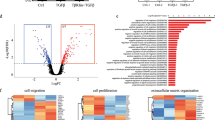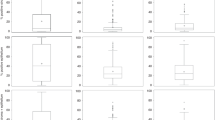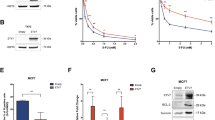Abstract
Accumulating evidence suggests that a subpopulation of breast cancer cells, referred to as cancer stem cells (CSCs), have the ability to propagate a tumor and potentially seed new metastases. Furthermore, stimulation of an epithelial-to-mesenchymal transition by factors like transforming growth factor-β (TGFβ) is accompanied with the generation of breast CSCs. Previous observations indicated that bone morphogenetic protein-7 (BMP7) antagonizes the protumorigenic and prometastatic actions of TGFβ, but whether BMP7 action is mechanistically linked to breast CSCs has remained elusive. Here, we have studied the effects of BMP7, BMP2 and a BMP2/7 heterodimer on the formation of human breast CSCs (ALDHhi/CD44hi/CD24−/low) and bone metastases formation in a preclinical model of intra-cardiac injection of MDA-MB-231 cells in athymic nude (Balb/c nu/nu) mice. The BMP2/7 heterodimer was the most efficient stimulator of BMP signaling and very effectively reduced TGFβ-driven Smad signaling and cancer cell invasiveness. The tested BMPs—particularly the heterodimeric BMP2/7—strongly reduced the size of the ALDHhi/CD44hi/CD24−/low CSC subpopulation. In keeping with these in vitro observations, pretreatment of cancer cells with BMPs for 72 h prior to systemic inoculation of the cancer cells inhibited the formation of bone metastases. Collectively, our data support the notion that breast CSCs are involved in bone metastasis formation and describe heterodimeric BMP2/7 as a powerful TGFβ antagonist with anti-metastatic potency.
This is a preview of subscription content, access via your institution
Access options
Subscribe to this journal
Receive 50 print issues and online access
$259.00 per year
only $5.18 per issue
Buy this article
- Purchase on SpringerLink
- Instant access to full article PDF
Prices may be subject to local taxes which are calculated during checkout





Similar content being viewed by others
References
Al-Hajj M, Wicha MS, Benito-Hernandez A, Morrison SJ, Clarke MF . (2003). Prospective identification of tumorigenic breast cancer cells. Proc Natl Acad Sci USA 100: 3983–3988.
Alison MR, Guppy NJ, Lim SM, Nicholson LJ . (2010). Finding cancer stem cells: are aldehyde dehydrogenases fit for purpose? J Pathol 222: 335–344.
Balic M, Lin H, Young L, Hawes D, Giuliano A, McNamara G et al. (2006). Most early disseminated cancer cells detected in bone marrow of breast cancer patients have a putative breast cancer stem cell phenotype. Clin Cancer Res 12: 5615–5621.
Buijs JT, Henriquez NV, van Overveld PG, van der Horst G, Que I, Schwaninger R et al. (2007a). Bone morphogenetic protein 7 in the development and treatment of bone metastases from breast cancer. Cancer Res 67: 8742–8751.
Buijs JT, Henriquez NV, van Overveld PG, van der Horst G, ten Dijke P, van der Pluijm G . (2007b). TGF-beta and BMP7 interactions in tumour progression and bone metastasis. Clin Exp Metastasis 24: 609–617.
Buijs JT, Rentsch CA, van der Horst G, van Overveld PG, Wetterwald A, Schwaninger R et al. (2007c). BMP7, a putative regulator of epithelial homeostasis in the human prostate, is a potent inhibitor of prostate cancer bone metastasis in vivo. Am J Pathol 171: 1047–1057.
Cheung AM, Wan TS, Leung JC, Chan LY, Huang H, Kwong YL et al. (2007). Aldehyde dehydrogenase activity in leukemic blasts defines a subgroup of acute myeloid leukemia with adverse prognosis and superior NOD/SCID engrafting potential. Leukemia 21: 1423–1430.
Coleman RE . (1997). Skeletal complications of malignancy. Cancer 80: 1588–1594.
Collins AT, Berry PA, Hyde C, Stower MJ, Maitland NJ . (2005). Prospective identification of tumorigenic prostate cancer stem cells. Cancer Res 65: 10946–10951.
Cook C, Vezina CM, Allgeier SH, Shaw A, Yu M, Peterson RE et al. (2007). Noggin is required for normal lobe patterning and ductal budding in the mouse prostate. Dev Biol 312: 217–230.
Creighton CJ, Li X, Landis M, Dixon JM, Neumeister VM, Sjolund A et al. (2009). Residual breast cancers after conventional therapy display mesenchymal as well as tumor-initiating features. Proc Natl Acad Sci USA 106: 13820–13825.
Creighton CJ, Chang JC, Rosen JM . (2010). Epithelial–mesenchymal transition (EMT) in tumor-initiating cells and its clinical implications in breast cancer. J Mammary Gland Biol Neoplasia 15: 253–260.
Dennler S, Itoh S, Vivien D, ten Dijke P, Huet S, Gauthier JM . (1998). Direct binding of Smad3 and Smad4 to critical TGF beta-inducible elements in the promoter of human plasminogen activator inhibitor-type 1 gene. EMBO J 17: 3091–3100.
Ginestier C, Hur MH, Charafe-Jauffret E, Monville F, Dutcher J, Brown M et al. (2007). ALDH1 is a marker of normal and malignant human mammary stem cells and a predictor of poor clinical outcome. Cell Stem Cell 1: 555–567.
Grishina IB, Kim SY, Ferrara C, Makarenkova HP, Walden PD . (2005). BMP7 inhibits branching morphogenesis in the prostate gland and interferes with Notch signaling. Dev Biol 288: 334–347.
Hazama M, Aono A, Ueno N, Fujisawa Y . (1995). Efficient expression of a heterodimer of bone morphogenetic protein subunits using a baculovirus expression system. Biochem Biophys Res Commun 209: 859–866.
Hollier BG, Evans K, Mani SA . (2009). The epithelial-to-mesenchymal transition and cancer stem cells: a coalition against cancer therapies. J Mammary Gland Biol Neoplasia 14: 29–43.
Israel DI, Nove J, Kerns KM, Kaufman RJ, Rosen V, Cox KA et al. (1996). Heterodimeric bone morphogenetic proteins show enhanced activity in vitro and in vivo. Growth Factors 13: 291–300.
Jemal A, Siegel R, Xu J, Ward E . (2010). Cancer statistics, 2010. CA Cancer J Clin 60: 277–300.
Klose A, Waerzeggers Y, Monfared P, Vukicevic S, Kaijzel EL, Winkeler A et al. (2011). Imaging bone morphogenetic protein 7 induced cell cycle arrest in experimental gliomas. Neoplasia 13: 276–285.
Koh JT, Zhao Z, Wang Z, Lewis IS, Krebsbach PH, Franceschi RT . (2008). Combinatorial gene therapy with BMP2/7 enhances cranial bone regeneration. J Dent Res 87: 845–849.
Kong D, Banerjee S, Ahmad A, Li Y, Wang Z, Sethi S et al. (2010). Epithelial to mesenchymal transition is mechanistically linked with stem cell signatures in prostate cancer cells. PLoS One 5: e12445.
Korchynskyi O, ten Dijke P . (2002). Identification and functional characterization of distinct critically important bone morphogenetic protein-specific response elements in the Id1 promoter. J Biol Chem 277: 4883–4891.
Li X, Lewis MT, Huang J, Gutierrez C, Osborne CK, Wu MF et al. (2008). Intrinsic resistance of tumorigenic breast cancer cells to chemotherapy. J Natl Cancer Inst 100: 672–679.
Mani SA, Guo W, Liao MJ, Eaton EN, Ayyanan A, Zhou AY et al. (2008). The epithelial–mesenchymal transition generates cells with properties of stem cells. Cell 133: 704–715.
Notting IC, Buijs JT, Que I, Mintardjo RE, van der Horst G, Karperien M et al. (2005). Whole-body bioluminescent imaging of human uveal melanoma in a new mouse model of local tumor growth and metastasis. Invest Ophthalmol Vis Sci 46: 1581–1587.
O'Brien CA, Pollett A, Gallinger S, Dick JE . (2007). A human colon cancer cell capable of initiating tumour growth in immunodeficient mice. Nature 445: 106–110.
Petersen M, Pardali E, van der Horst G, Cheung H, van den Hoogen C, van der Pluijm G et al. (2010). Smad2 and Smad3 have opposing roles in breast cancer bone metastasis by differentially affecting tumor angiogenesis. Oncogene 29: 1351–1361.
Piccirillo SG, Reynolds BA, Zanetti N, Lamorte G, Binda E, Broggi G et al. (2006). Bone morphogenetic proteins inhibit the tumorigenic potential of human brain tumour-initiating cells. Nature 444: 761–765.
Polyak K, Weinberg RA . (2009). Transitions between epithelial and mesenchymal states: acquisition of malignant and stem cell traits. Nat Rev Cancer 9: 265–273.
Reya T, Morrison SJ, Clarke MF, Weissman IL . (2001). Stem cells, cancer, and cancer stem cells. Nature 414: 105–111.
Ricci-Vitiani L, Lombardi DG, Pilozzi E, Biffoni M, Todaro M, Peschle C et al. (2007). Identification and expansion of human colon-cancer-initiating cells. Nature 445: 111–115.
Schwaninger R, Rentsch CA, Wetterwald A, van der Horst G, van Bezooijen RL, van der Pluijm G et al. (2007). Lack of noggin expression by cancer cells is a determinant of the osteoblast response in bone metastases. Am J Pathol 170: 160–175.
Shipitsin M, Campbell LL, Argani P, Weremowicz S, Bloushtain-Qimron N, Yao J et al. (2007). Molecular definition of breast tumor heterogeneity. Cancer Cell 11: 259–273.
Singh A, Settleman J . (2010). EMT, cancer stem cells and drug resistance: an emerging axis of evil in the war on cancer. Oncogene 29: 4741–4751.
Singh SK, Hawkins C, Clarke ID, Squire JA, Bayani J, Hide T et al. (2004). Identification of human brain tumour initiating cells. Nature 432: 396–401.
Tan AR, Alexe G, Reiss M . (2009). Transforming growth factor-beta signaling: emerging stem cell target in metastatic breast cancer? Breast Cancer Res Treat 115: 453–495.
ten Dijke P . (2006). Bone morphogenetic protein signal transduction in bone. Curr Med Res Opin 22 (Suppl 1): S7–S11.
Uchino M, Kojima H, Wada K, Imada M, Onoda F, Satofuka H et al. (2010). Nuclear beta-catenin and CD44 upregulation characterize invasive cell populations in non-aggressive MCF-7 breast cancer cells. BMC Cancer 10: 414.
Valera E, Isaacs MJ, Kawakami Y, Izpisua Belmonte JC, Choe S . (2010). BMP-2/6 heterodimer is more effective than BMP-2 or BMP-6 homodimers as inductor of differentiation of human embryonic stem cells. PLoS One 5: e11167.
van den Hoogen C, van der Horst G, Cheung H, Buijs JT, Lippitt JM, Guzman-Ramirez N et al. (2010). High aldehyde dehydrogenase activity identifies tumor-initiating and metastasis-initiating cells in human prostate cancer. Cancer Res 70: 5163–5173.
van der Pluijm G, Que I, Sijmons B, Buijs JT, Lowik CW, Wetterwald A et al. (2005). Interference with the microenvironmental support impairs the de novo formation of bone metastases in vivo. Cancer Res 65: 7682–7690.
van der Pluijm G . (2010). Epithelial plasticity, cancer stem cells and bone metastasis formation. Bone 48: 37–43.
Wellner U, Schubert J, Burk UC, Schmalhofer O, Zhu F, Sonntag A et al. (2009). The EMT-activator ZEB1 promotes tumorigenicity by repressing stemness-inhibiting microRNAs. Nat Cell Biol 11: 1487–1495.
Wicha MS, Liu S, Dontu G . (2006). Cancer stem cells: an old idea—a paradigm shift. Cancer Res 66: 1883–1890; discussion 1895–1886.
Winquist RJ, Boucher DM, Wood M, Furey BF . (2009). Targeting cancer stem cells for more effective therapies: taking out cancer's locomotive engine. Biochem Pharmacol 78: 326–334.
Woodward WA, Chen MS, Behbod F, Alfaro MP, Buchholz TA, Rosen JM . (2007). WNT/beta-catenin mediates radiation resistance of mouse mammary progenitor cells. Proc Natl Acad Sci USA 104: 618–623.
Zhao M, Zhao Z, Koh JT, Jin T, Franceschi RT . (2005). Combinatorial gene therapy for bone regeneration: cooperative interactions between adenovirus vectors expressing bone morphogenetic proteins 2, 4, and 7. J Cell Biochem 95: 1–16.
Zhu W, Rawlins BA, Boachie-Adjei O, Myers ER, Arimizu J, Choi E et al. (2004). Combined bone morphogenetic protein-2 and -7 gene transfer enhances osteoblastic differentiation and spine fusion in a rodent model. J Bone Miner Res 19: 2021–2032.
Acknowledgements
We are grateful to Professor Dr P ten Dijke for providing the reporter constructs. JTB and GvdH were sponsored by the European Sixth Framework Programme PRIMA; CvdH and HC were sponsored by the European Sixth Framework Programme PROMET; MP was sponsored by the European Sixth Framework Programme BRECOSM and PGMvO was sponsored by a grant from Dutch Cancer Society (KWF project UL-2004-3028).
Author information
Authors and Affiliations
Corresponding author
Ethics declarations
Competing interests
The authors declare no conflict of interest.
Additional information
Supplementary Information accompanies the paper on the Oncogene website
Supplementary information
Rights and permissions
About this article
Cite this article
Buijs, J., van der Horst, G., van den Hoogen, C. et al. The BMP2/7 heterodimer inhibits the human breast cancer stem cell subpopulation and bone metastases formation. Oncogene 31, 2164–2174 (2012). https://doi.org/10.1038/onc.2011.400
Received:
Revised:
Accepted:
Published:
Issue date:
DOI: https://doi.org/10.1038/onc.2011.400
Keywords
This article is cited by
-
Current understanding of epigenetics mechanism as a novel target in reducing cancer stem cells resistance
Clinical Epigenetics (2021)
-
Cancer-associated fibroblast-derived Gremlin 1 promotes breast cancer progression
Breast Cancer Research (2019)
-
All-trans retinoic-acid inhibits heterodimeric bone morphogenetic protein 2/7-stimulated osteoclastogenesis, and resorption activity
Cell & Bioscience (2018)
-
BMP-2 induces EMT and breast cancer stemness through Rb and CD44
Cell Death Discovery (2017)
-
Oncostatin M promotes cancer cell plasticity through cooperative STAT3-SMAD3 signaling
Oncogene (2017)



